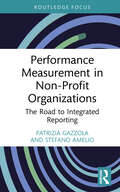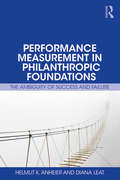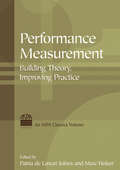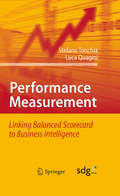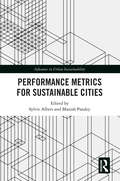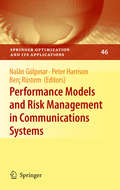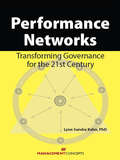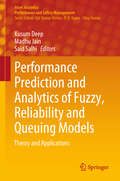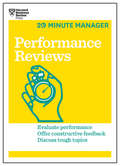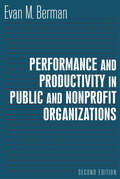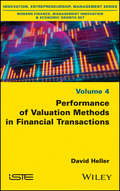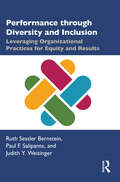- Table View
- List View
Performance Measurement in Non-Profit Organizations: The Road to Integrated Reporting (Routledge Focus on Business and Management)
by Patrizia Gazzola Stefano AmelioPerformance Measurement in Non-Profit Organizations: The Road to Integrated Reporting addresses the issue of performance measurement in nonprofit companies with the aim of defining a system of useful measures to understand, manage, and improve the performance of such companies by employing systems theory to examine their conditions of existence and manifestations of life. From the proposed company model follows that the system of performance measures should make it possible to keep under control both the productive transformation, with the physical-technical efficiency indicators, and the economic transformation, with the economic efficiency indicators, and the financial transformation with the financial efficiency indicators, and finally the managerial transformation with the effectiveness indicators, taking into account the degree of satisfaction of the expectations of the main categories of company stakeholders. Readers will understand that economic analysis alone is not sufficient to assess the performance of such organizations, but it is necessary to unite it with the analysis of sustainability dimensions. It would therefore be appropriate to draw up an integrated report that combines the economic and financial dimensions with the pillars of sustainability, as in the case of companies in the second sector. There is a gap in the literature in this area that this book aims to fill, making it a valuable resource to researchers, academics, and advanced students interested in performance evaluation of NPOs.
Performance Measurement in Philanthropic Foundations: The Ambiguity of Success and Failure
by Helmut K. Anheier Diana LeatThe growth of philanthropic foundations in numbers and significance raises two immediate questions. First, what makes for success and failure of foundations’ projects and activities? Second, what yardsticks or benchmarks are used to measure performance and track goal attainment? The purpose of this book is to delve deeper into the complex set of issues that lie behind the performance and wider impact of philanthropy. Performance Measurement in Philanthropic Foundations looks at the strengths and weaknesses of philanthropic foundations, which are independent of both the market and ballot box and yet open to signal and incentive deficiencies. The authors use in-depth case studies from different countries to illustrate the problems and challenge much of the conventional wisdom on foundation "success" and "failure." The book also outlines the main contours of a proactive governance and management style to address those problems.
Performance Measurement with the Balanced Scorecard: A Practical Approach to Implementation within SMEs
by Stefano Biazzo Patrizia GarengoDo we really know the critical phenomena that are linked to how enterprises function and the dynamics of their relationships with customers, suppliers and competitors? Are their decision-making processes founded upon a set of performance measurements that were accurately designed and systematically elaborated? The above questions are the focus of this book, as is the following premise: enterprises need a system to measure their critical performances so they can be managed effectively; metaphorically speaking, enterprises need a "management dashboard" to serve as a navigational aid. A dashboard to show - with as few distortions as possible - the pattern of key variables that characterizes the specific formula enterprises use to face their competitive and social environment.
Performance Measurement: Building Theory, Improving Practice (Aspa Classics Ser.)
by Marc Holzer Patria de JulnesThis volume in the "ASPA Classics" series compiles the most influential contributions to the theory and practice of performance measurement that have been published in various journals affiliated with the American Society for Public Administration. The book includes major sections of original text along with the readings, and provides students and practitioners with a handy reference source for theory development and practice improvement in performance measurement. The coverage is broad, including methods and techniques for developing effective performance measurement systems, building performance-based management systems, and sustaining performance-based budgeting. The articles are all classics in the field that have endured the test of time and are considered 'must reads' on performance measurement.
Performance Measurement: Linking Balanced Scorecard to Business Intelligence
by Luca Quagini Stefano TonchiaThis book describes - in a precise but practical way - the most recent developments in performance measurement and the relative Performance Measurement Systems (PMS), whose most famous one is the Balanced Scorecard model. It is unique because it combines PMS theory (types of performances, key performance indicators, architecture and integration with ERP, organization and strategy) with Business Intelligence technologies, which characterize the most advanced effective solutions. The rigorous academic approach of a well-known international expert - Prof. Tonchia - is mixed with the managerial contribution of a European ICT & consulting leader - SDG Group. There are very few, if any, books in the performance management field that describe in detail a real approach for designing and managing these systems, with the amount of detail and giving the useful, practical understanding of the underlying principles and specific processes and practices that are presented here.
Performance Metrics for Sustainable Cities (Advances in Urban Sustainability)
by SylvieManish Albert PandeyPerformance Metrics for Sustainable Cities provides an overview of measurement systems and tools to enable communities to self-assess and benchmark their progress along a continuum of smart, intelligent, and sustainable development. It begins by explaining the importance of measurement and evaluation for cities and smaller communities, as well as future factors that will need to be considered and embedded into planning processes. Across 14 chapters, the book describes existing evaluation mechanisms that are being used for government funding decisions, awards of recognition, and new measurement systems to assess what makes a city smarter and more sustainable, such as broader sustainable goal targets (UN SDGs), green cities, fabrication cities, and compassionate cities. It presents examples of metrics used for important sustainability and liveability concepts for cities such as how to measure trust, engagement, compassion, circular economy, and so forth. The book ends with reflections on the feasibility of a holistic system of measurement and the implications of its implementation. This volume will be of great interest to students, researchers, and professionals of urban sustainability, planning, smart cities, and sustainable communities.
Performance Models and Risk Management in Communications Systems
by Berc Rustem Nalân Gülpınar Peter G. HarrisonThis volume covers recent developments in the design, operation, and management of mobile telecommunication and computer systems. Uncertainty regarding loading and system parameters leads to challenging optimization and robustness issues. Stochastic modeling combined with optimization theory ensures the optimum end-to-end performance of telecommunication or computer network systems. In view of the diverse design options possible, supporting models have many adjustable parameters and choosing the best set for a particular performance objective is delicate and time-consuming. An optimization based approach determines the optimal possible allocation for these parameters. Researchers and graduate students working at the interface of telecommunications and operations research will benefit from this book. Due to the practical approach, this book will also serve as a reference tool for scientists and engineers in telecommunication and computer networks who depend upon optimization.
Performance Networks: Transforming Governance for the 21st Century
by Lynn S. Kahn PhDProblems cross boundaries and so must solutions. Multi-agency, cross-boundary coordination and partnerships are needed to solve today's problems. These networks coordinate, communicate, and leverage resources and best practices to deliver measurable results across traditional agency boundaries. Performance Networks: Transforming Governance for the 21st Century provides roadmaps and guidelines for executives, managers, and team leaders who are accountable for results in the new world of interagency networks that aim to deliver measurable results across traditional boundaries. The author presents ten "views" of performance networks, adapted from current, successful, multi-agency partnerships; these views provide specific guidance on transformational strategic planning to deliver better results.Working across government agencies and boundaries is difficult at any level of government, but it may be the only solution for today's problems. Performance Networks: Transforming Governance for the 21st Century offers the public manager a valuable new governance tool. This resource provides a practical approach to:• Understanding the history and workings of government-based networks• Establishing multi-agency, cross boundary partnerships and making them work• Improving citizen engagement
Performance Pay at Safelite Auto Glass (A)
by Brian J. Hall Carleen Madigan Edward LazearDescribes a company's changing of its compensation and incentive plan. In particular, it shows how a change from hourly pay to piece rate pay (for windshield installers) affected productivity, pay, and turnover.
Performance Pay at Safelite Auto Glass (B)
by Brian J. Hall Carleen Madigan Edward LazearSupplements the (A) case.
Performance Pay for MGOA Physicians (A)
by Kevin J. Bozic Aaron M.G. Zimmerman Jason R. BarroExamines the transition of an orthopedic surgical group at a premier teaching and research hospital from a system in which the surgeons are compensated with flat salaries to a system where they are compensated based on profitability. Allows for an examination of several critical issues in incentive strategy, including pay-to-performance in a not-for-profit environment, whether a compensation system is truly aligned with value creation (issues of quality of care and research time), and the difficulty in designing a compensation system in a competitive labor market when the objectives of the institution extend beyond pure profit maximization. This is a rewritten version of an earlier case.
Performance Planning and Review: Making employee appraisals work
by Richard RudmanManaging employees' performance is central to the role of every manager. Yet few organisations or managers are satisfied with their performance management systems - and few employees look forward to their performance reviews. This discontent has two main causes: first, employees' performance is often managed in isolation from the plans and targets of the work group or business unit; and second, the organisation is using inappropriate systems and methods of performance management.Performance Planning and Review describes how systematic performance management - planning, monitoring, reviewing, rewarding and developing what individual employees and work teams do - is the key to organisational success in today's complex and competitive world. Using practical examples, the author outlines the options available to organisations and managers, and discusses how to work out what is best for your organisation.Performance Planning and Review has been popular with managers, human resources specialists, students and others since its original publication. This new edition has been substantially revised to capture the latest research and good practice. It includes extensive coverage of new techniques like 360-degree feedback, and to open up new areas such as performance planning and review for teams.
Performance Prediction and Analytics of Fuzzy, Reliability and Queuing Models: Theory and Applications (Asset Analytics)
by Kusum Deep Madhu Jain Said SalhiThis book presents the latest developments and breakthroughs in fuzzy theory and performance prediction of queuing and reliability models by using the stochastic modeling and optimization theory. The main focus is on analytics that use fuzzy logic, queuing and reliability theory for the performance prediction and optimal design of real-time engineering systems including call centers, telecommunication, manufacturing, service organizations, etc. For the day-to-day as well as industrial queuing situations and reliability prediction of machining parts embedded in computer, communication and manufacturing systems, the book assesses various measures of performance and effectiveness that can provide valuable insights and help arrive at the best decisions with regard to service and engineering systems. In twenty chapters, the book presents both theoretical developments and applications of the fuzzy logic, reliability and queuing models in a diverse range of scenarios. The topics discussed will be of interest to researchers, educators and undergraduate students in the fields of Engineering, Business Management, and the Mathematical Sciences.
Performance Provided, Market Demand, and the Product Life Cycle
by Clayton M. ChristensenPerformance oversupply creates a fundamental change in the basis of competition in the market, often triggering product commoditization. Historically, when performance oversupply occurs, it creates an opportunity for a disruptive technology to emerge and invade established markets from below. This chapter uses several industry examples to illustrate this phenomenon. This chapter was originally published as chapter 9 of "The Innovator's Dilemma: When New Technologies Cause Great Firms to Fail."
Performance Review: Joseph Park and Elena Ram rez
by David G. Fubini Patrick SanguinetiNiya Jones, a Partner at a major management consulting firm, must review the work of two of her mentees--Joseph Park and Elena Ram rez--for their first end-of-year performance review as new Project Leaders. Both have produced strong results in their new roles, but neither Park nor Ram rez could be more different in how they went about leading their respective teams. How should Jones evaluate these Project Leaders according to the criteria developed by her firm?
Performance Reviews (HBR 20-Minute Manager Series)
by Harvard Business ReviewConducting performance reviews can be stressful. But these conversations are critical to your employees' development, allowing you to formally communicate with them about their accomplishments relative to their goals. Performance Reviews guides you through the basics. You'll learn to: Gather and analyze the right information Document your assessment Address performance problems Set challenging goalsAbout HBR's 20-Minute Manager Series:Don't have much time? Get up to speed fast on the most essential business skills with HBR's 20-Minute Manager series. Whether you need a crash course or a brief refresher, each book in the series is a concise, practical primer that will help you brush up on a key management topic.Advice you can quickly read and apply, for ambitious professionals and aspiring executives-from the most trusted source in business. Also available as an ebook.
Performance Reviews and Coaching: The Performance Management Collection (5 Books)
by Harvard Business Review Dick GroteIf you're an executive, manager, or team leader, one of your toughest responsibilities is managing your people's performance. This digital collection, curated by Harvard Business Review, will help you evaluate employee performance, provide coaching, conduct performance reviews, give effective feedback, and more; it includes Dick Grote's How to be Good at Performance Appraisals; Harvard Business Essentials' Performance Management; the HBR Guide to Coaching Employees; and Giving Effective Feedback and Performance Reviews, both from HBR's 20-Minute Manager Series.
Performance Through Learning: Knowledge Management In Practice (Improving Human Performance Ser.)
by Kurt April Nick Milton, Ph.D. Carol GorelickPerformance Through Learning is a practical guide to the key issues surrounding knowledge management from a human resource perspective and provides incisive insights into developing a strategy linked to organizational learning. The authors present a framework and model that practitioners within organizations can adapt to increase performance through learning using knowledge management tools. The book is divided into two parts and includes: *An overview of theory *Case studies and practitioner stories from a range of KM initiatives *Tools and techniques for implementing an effective KM strategy. Written by a respected international author team, the book provides an understanding of the theory that supports knowledge management in the current business environment. Drawing upon real-life examples across a variety of organizational settings, from large global financial and professional services firms, to multinational oil and mining companies, to a small charity in the voluntary sector
Performance and Productivity in Public and Nonprofit Organizations
by Evan BermanDesigned for course adoption as well as professional use, the revised edition of this accessible text provides a balanced assessment and overview of state-of-the-art organizational and performance productivity strategies. Public and nonprofit organizations face demands for increased productivity and responsiveness, and this practical guide offers strategies based on current research and scholarship that respond to these challenges. The book's comprehensive coverage includes: rationale for productivity and performance improvement; evolution of productivity improvement; the quality paradigm; customer service; information technology; traditional approaches to productivity improvement; re-engineering and restructuring; partnering and privatization; psychological contracts; and community based strategies. In addition to updating the examples of the first edition, this new edition also highlights the growing use of enterprise funds, partnership models of privatization, and web-based service delivery. Each chapter concludes with a useful summary and all-new application exercises.
Performance at the Limit
by Mark Jenkins Mark Jenkins Ken Pasternak Richard West Ken PasternakCan you imagine your organisation as a Ferrari or a McLaren, a Toyota or a Force India? Your management team as a pit crew? Your sales force as the race team and your marketing and research department as the design studio creating a Formula 1 car? Formula 1 has an estimated turnover of $4bn, employs 50,000 people in more than 30 countries and has a foothold in every major and developing economy. With performance as the central focus of every organization, Performance at the Limit uses the case of Formula 1 motorsport as an example of how business can achieve optimal performance in highly competitive environments where dealing with change effectively is paramount. This second edition builds on the success of the first and contains a wealth of new material, including many more interviews with Formula 1 drivers and other key executives active in the sport.
Performance at the Limit
by Mark Jenkins Richard West Ken PasternakCan you imagine your organisation as a Ferrari or a McLaren, a Toyota or a Force India? Your management team as a pit crew? Your sales force as the race team and your marketing and research department as the design studio creating a Formula 1 car? Formula 1 has an estimated turnover of $4bn, employs 50,000 people in more than 30 countries and has a foothold in every major and developing economy. With performance as the central focus of every organization, Performance at the Limit uses the case of Formula 1 motorsport as an example of how business can achieve optimal performance in highly competitive environments where dealing with change effectively is paramount. This second edition builds on the success of the first and contains a wealth of new material, including many more interviews with Formula 1 drivers and other key executives active in the sport.
Performance of Pharmaceutical Companies in India: A Critical Analysis of Industrial Structure, Firm Specific Resources, and Emerging Strategies
by Mainak MazumdarThis book explains how government support and institutional set up facilitated the evolution of the Indian pharmaceutical industry and provides an economic analysis of firm strategies due to recent policy changes. The book is useful for researchers interested in understanding the transition of a lifeline sector for an emerging economy like India. Students of public policy, health administrators and health economists who are interested in the functioning of the pharmaceutical sector that produces life saving drugs in developing nations will find this book useful. The book also provides good coverage on data envelopment analysis (DEA), a useful technique for understanding productivity and efficiency. It can provide guidance to the research students on the applicability of DEA technique to address various research questions for analysis. The book will be a valuable addition to libraries in colleges of pharmacy and medicine as well as to all other academic and research centers.
Performance of Valuation Methods in Financial Transactions
by David HellerMODERN FINANCE, MANAGEMENT INNOVATION & ECONOMIC GROWTH SET Coordinated by Faten Ben Bouheni Financial operations depend on potential value creation, the nature of the shareholder base, the level of development of the company and its growth prospects. They result from different commercial and financial strategies that must integrate the interest of the capital holders, the influence and strategy of the group in the initiative and the structure of the offer. This book examines how, in practice, a company's capital is structured, taking into account the interests of various stakeholders. The performance of valuation methods, which serve investors in their decision-making and financial arrangements, is developed in detail. Depending on the contexts present in the control market, the methods of stock market and transactional comparables, discounted cash flows and the patrimonial approach, will be favored to assess the value of a company's shares. Performance of Valuation Methods in Financial Transactions is an in-depth analysis of equity transactions and is aimed at students and corporate finance professionals.
Performance through Diversity and Inclusion: Leveraging Organizational Practices for Equity and Results
by Ruth Sessler Bernstein Paul F. Salipante Judith Y. WeisingerThis book provides practical guidance for managers, leaders, diversity officers, educators, and students to achieve the benefits of diversity by focusing on creating meaningful, inclusive interactions. Implementing inclusive interaction practices, along with accountability practices, enhances performance outcomes for the organization and improves equity for members of historically underrepresented and marginalized groups. The book highlights the need to challenge existing approaches that have overemphasized representational—that is, numerical—diversity. For many decades, the focus has been on this important first step of increasing the numbers of underrepresented groups. However, moving beyond representation toward a truly inclusive organizational culture that produces real performance and equity has been elusive. This book moves the focus from achieving numerical diversity to achieving frequent, high-quality, equitable, and productive interactions that enable individuals to leverage their distinctive talents and provides the steps to do so. The benefits of this approach occur at the individual, workgroup, and organizational levels. Real-life examples of good inclusive practices are provided from across the for-profit, nonprofit, and governmental sectors and in various organizational contexts. The book is ideal not only for those charged with diversity, equity, and inclusion efforts in organizations but also for organizational leaders and managers who can create and/or support the implementing of inclusive organizational practices and also for postgraduate and undergraduate students studying human resource management, organizational behavior, management, or diversity, equity, and inclusion.
Performance, Dynamik und Konvergenz im Banking: Institutionenökonomische Analyse der Entscheidungsstrukturen in Sparkassen
by Robert ConradIn der Sparkassen-Finanzgruppe – mit 50 Mio. Kunden und über 300 Tsd. Beschäftigten eine der größten Bankengruppen der Welt – zeigen sich nach der internationalen Wirtschafts- und Finanzkrise Ende der 2000er Jahre erhebliche Konzentrationseffekte. Die Zinsentwicklung, die zunehmenden regulatorischen und aufsichtsrechtlichen Anforderungen sowie eine Veränderung des Kundenverhaltens stellen das Geschäftsmodell der Sparkassen vor erhebliche Herausforderungen. Am Beispiel der westfälisch-lippischen Sparkassen werden die Veränderungen im Leistungserstellungsprozess der Institute für die Dekade nach der Wirtschafts- und Finanzkrise nachvollzogen. Gleichzeitig wird die Vertriebsstruktur der Sparkassen analysiert und geprüft, inwiefern sich die verschiedenen Cluster von Instituten hinsichtlich Performance und Dynamik in ihrer Entwicklung unterscheiden. Diesbezüglich wird untersucht, ob die Anpassungsprozesse mit einer zunehmenden Konvergenz in der Entwicklung einhergehen. Die Analysen zahlen dabei stets auf die Kernfrage ein, welche Folgen sich aus der Entwicklung für die dezentral ausgerichteten Entscheidungsstrukturen der Sparkassen-Finanzgruppe ergeben.
